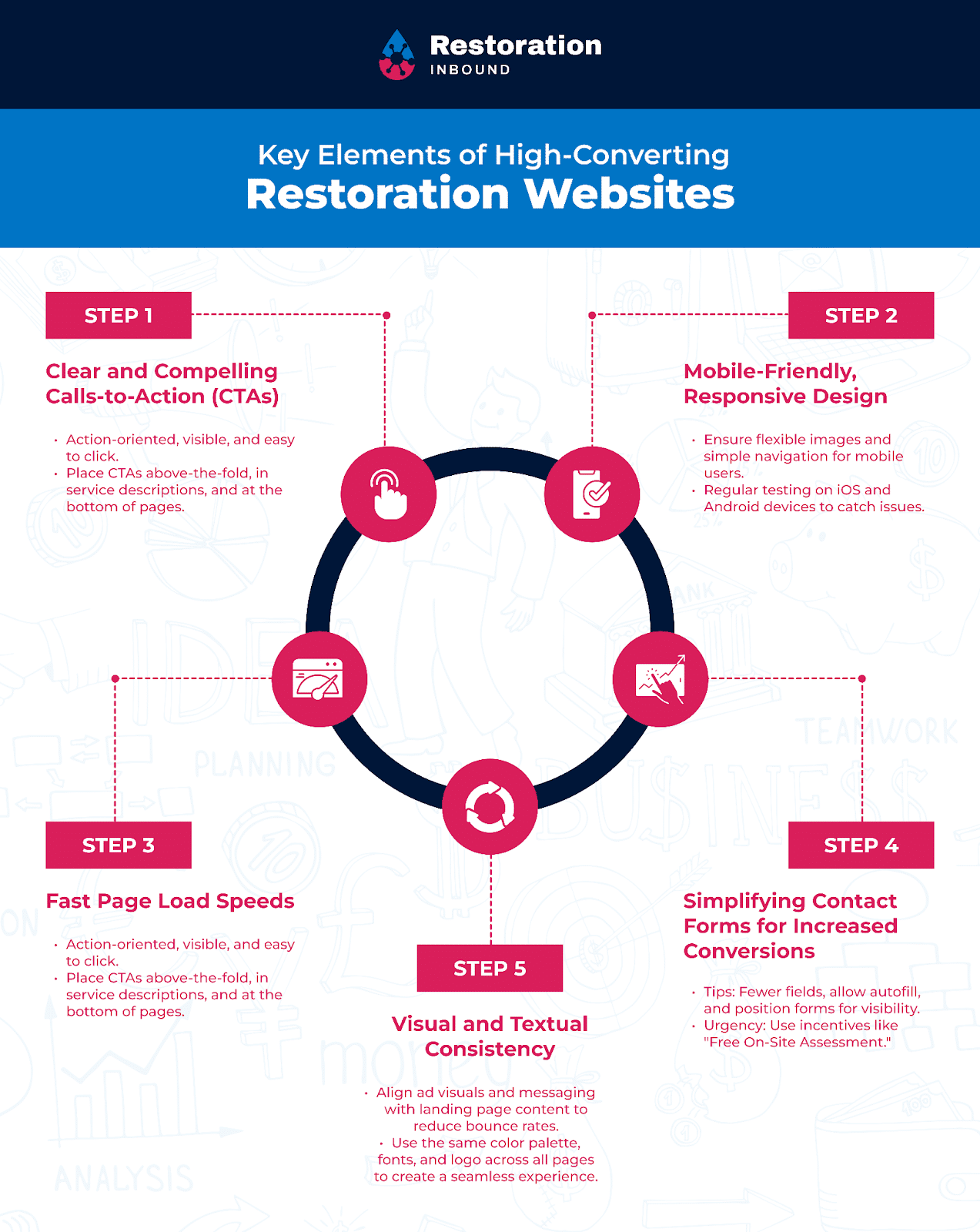Last Updated on June 18, 2025 by Hayk Saakian
Encouraging your site’s visitors to take action is the main goal of restoration website conversion optimization. It means making small changes to your website so more people ask for a free damage assessment or call your team. When you combine traffic-building strategies like SEO and PPC with strong conversion practices, you increase your chances of turning clicks into real jobs.
In this guide, we’ll share some simple, proven tips to help worried homeowners find your services and trust you when they need help the most.
What Is Conversion Optimization?
Conversion optimization is the process of fine-tuning your website so more visitors take the next step. In a restoration business, it means optimizing your content to turn your casual browsers into actionable leads. Conversion rate optimization (CRO) is all about making each visit count. Here’s how it works:
- SEO and PPC attract potential prospects through keywords, ads, and organic rankings.
- CRO uses landing pages, forms, and calls-to-action to encourage specific actions.
- To ensure maximum leads, restoration companies must balance traffic generation with conversion.
Key Elements of High-Converting Restoration Websites
In the restoration world, where emergencies arrive without warning, your website must act fast, guide visitors clearly, and never get in the way. During emergencies, people need quick action, so your website must be designed to convert effectively.

Clear and Compelling Calls-to-Action (CTAs)
When someone visits your website during a crisis, they need a clear and quick next step. Use strong calls-to-action (CTAs) like “Request Emergency Cleanup” or “Get a Free Mold Inspection” to guide them. Make sure your CTAs are easy to see, with bright colors, plenty of space around them, and large, tap-friendly buttons.
For the best results, place CTAs in several key spots, at the top of landing pages, inside service descriptions, at the end of blog posts, and in the header or footer. Clear and noticeable CTAs make it easier for visitors to act fast when they need your help the most.
Mobile-Friendly, Responsive Design
Most homeowners usually use their phones first when they spot water stains or mold. If your site isn’t optimized for mobile, visitors can get frustrated because it’s hard for them to find the information they need. To avoid these pitfalls:
- Use flexible images and layouts to adapt to any screen size.
- Keep navigation simple, with clear menus and search where needed.
- Test regularly on iOS and Android to catch slow loading or layout glitches.
Fast Page Load Speeds
Every second matters when someone visits your website. Slow-loading pages can frustrate visitors and hurt your Google rankings. That’s why it’s so important to make sure your site loads quickly, especially when stressed homeowners are looking for help.
To speed up your site, optimize images using compression and newer formats. Use browser caching and minify your code. Regularly check your site’s performance with tools like Google PageSpeed Insights or GTmetrix. If your pages load quickly, you will keep visitors around longer and increase your chances of turning them into customers.
Optimizing Landing Pages for Restoration PPC Campaigns
When someone clicks on your paid ad and lands on your page, everything on that page should work together. Your goal is simple: show people in a stressful situation that you understand what they are going through and make it easy for them to contact you. Here are some landing page best practices for restoration companies:
Addressing Customer Pain Points Clearly
During emergencies, homeowners dealing with mold or water damage are under a lot of stress. So, it is important to address their main concerns clearly. You can start with a concerning headline like “We understand how serious this situation is. Our certified team responds quickly to inspect, contain, and restore your home.”
Also, organize your content with clear subheadings like “Health and Safety First” and “Fast Emergency Cleanup” to help visitors find key information easily. Make sure to speak directly to their concerns, because it will build trust and make it easier for them to take the next step.
Simplifying Contact Forms for Increased Conversions
Sometimes, lengthy forms can turn visitors away, especially when they need quick help. Make sure to keep your form simple and easy, which helps people take action without hesitation. Here are some tips to keep it simple and user-friendly:
- Fewer fields: Only ask for essential information like name, phone number, and type of damage.
- Allow autofill: Allow browsers to auto-complete details like phone numbers and email addresses.
- Position for visibility: Place the form just below your main headline and again at the bottom of the page.
- Add urgency and incentives: Use messages like “Free On-Site Assessment” to encourage quick responses.
Visual and Textual Consistency
To keep visitors engaged, make sure your message matches your landing page. Also, match your visuals by using real images of your team in action if that’s what your ad shows, not a random stock photo.
Keep the colors, fonts, and CTAs of your landing page consistent to create a smooth experience that builds confidence. When visitors instantly recognize they are in the right place, it builds trust and can lead to much higher conversion rates.
Building Trust through Social Proof and Certifications
Trust is the foundation of any restoration project. When homeowners are stressed about damage, they look for clear signals that they are choosing a reputable, reliable team.

Utilizing Customer Testimonials Effectively
To gain trust and prove the quality of your services, show real feedback from customers. Ask for reviews right after a job is finished, and the experience is still fresh. Pair these reviews with before-and-after images or highlight key points in your reviews to make them more convincing.
You can also boost credibility by adding third-party reviews from sites like Google or Yelp directly to your page. Add these close to your contact form to help new visitors quickly see that others have trusted you and had great results.
Showcasing Certifications and Affiliations
Display official credentials on your site to show visitors that you meet industry standards and are trustworthy. Place trust badges, such as certifications and accreditations, on your page, near your headline or primary call-to-action button.
Restoration companies that display certification badges and mention their training standards are likely to have more inquiries. Because these signals reassure visitors that they are dealing with qualified experts, and encourage them to take action.
Effective Content and Copywriting Strategies
Every word on your restoration site must be written to push visitors to fill out the forms. It requires effective copywriting skills, which not only informs the readers but also encourages them to take action.
Creating Urgency and Scarcity in Your Messaging
When emergencies like water damage or mold growth happen, it creates urgency. So, your website copy should reflect that urgent need. You can start with strong and concerning headlines to show visitors you understand their situation and use short, action-focused phrases to encourage quick action.
However, make sure to be honest about your services. If you cannot offer service within an hour, clearly state that. Also, include messages like Limited Inspection Slots under the main headline, as these actions keep the urgency real and build trust.
Writing Benefit-Focused, Customer-Centric Content
Always state clear outcomes in your messaging that show how your services make life easier, safer, or more comfortable for homeowners. Focus on promises that you can sell benefits, rather than just listing technical tools or processes.
Also, avoid common mistakes that make your copy harder to connect with. Skip complex terms that homeowners might not understand, and use strong, active language that creates urgency. When your content focuses on real results, you make it easier to turn visitors into leads.
Continuous Testing and Optimization Strategies
Even after your landing page is live and bringing in leads, there is always room to make it better. By regularly checking and improving it, you can keep your restoration PPC campaigns bringing in more leads over time.
Implementing A/B Testing for Ongoing Improvements
A/B testing, also called split testing, helps you find out which version of your page gets more leads. In this approach, you show half your visitors the current version and the other half a slightly changed version. You change one thing at a time, like the CTA text, form length, or the main image, to see what makes a real difference.
You can use tools like Google Optimize to set up and track your tests. Start with a clear goal and let the test run until you have enough results to be sure of the winner. Compare the results and use these small improvements to design a page for better performance.
Analyzing Data to Inform Optimization
To ensure that your landing page performs continuously, it is essential to track results and improve your strategy. You can use tools like Google Analytics, as it can help you track performance and see where visitors lose interest, and what changes could boost conversions. You can focus on these important metrics:
- Conversion rate: Percentage of visitors who submit your form or call.
- Bounce rate: How many leave after viewing only one page.
- Time on page: Shows how interested visitors are and how well your content holds their attention.
Your Restoration Growth Starts Here
Conversion optimization is essential for turning your website traffic into valuable customer leads. By focusing on clear CTAs, mobile-friendly design, fast load speeds, and customer-centric messaging, you can significantly boost your lead generation. Start applying these strategies today to transform your restoration website into a true growth engine for your business.
Ready to attract more qualified leads and grow your restoration business?
Contact Restoration Inbound today to discover how powerful targeted traffic can transform your business!
Frequently Asked Questions
Why is conversion optimization critical for restoration businesses?
Conversion optimization ensures that every visitor to your restoration website becomes an actionable lead. It helps maximize the return on your efforts by turning traffic into real customers.
What are the quickest ways to improve landing page conversions for restoration websites?
Focus on clear and visible calls-to-action, simplify contact forms, and address customer pain points. Also, make sure your website is fast-loading and has an adaptive design.
How do I know if my restoration website is effectively optimized for mobile users?
Check if your website loads quickly, adapts smoothly to different screen sizes, and has simple navigation buttons. Test your site on both Android and iOS devices to spot and fix mobile usability issues.
What types of trust signals are most impactful on restoration websites?
Customer testimonials, before-and-after project photos, third-party reviews, and certifications are highly effective trust signals that can reassure visitors and encourage them to contact you.
Can small changes really make a significant difference in my site’s conversions?
Yes, even minor adjustments like changing your CTA wording, simplifying a contact form, or improving page speed can significantly impact visitor behavior and generate noticeable results.
References
https://backlinko.com/conversion-rate-optimization
https://www.justuno.com/blog/key-elements-of-a-website-that-converts
https://www.wordstream.com/landing-page-optimization